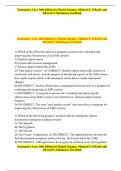Exam (elaborations)
Complete Test Bank Emergency Care 14th Edition Daniel Limmer Questions & Answers with rationales (Chapter 1-41)
- Course
- Institution
- Book
Emergency Care 14th Edition Daniel Limmer Test Bank Complete Test Bank Emergency Care 14th Edition Daniel Limmer Questions & Answers with rationales (Chapter 1-41) PDF File All Pages All Chapters Grade A+ GRADEXAM
[Show more]



